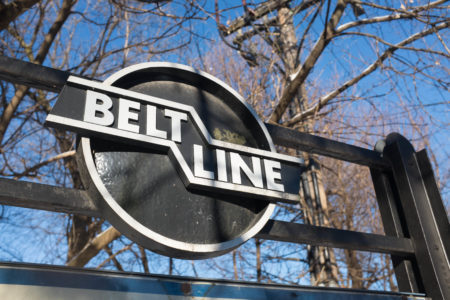Beltline Trail
“BELT LINE”
Snowy hill
SARS-CoV-2 Omicron variant
Ontario’s COVID-19 dashboard is showing a shocking effective reproduction number for the omicron variant:
The figure is highly concerning both because it suggests higher transmissibility for omicron than for past variants and because, by extension, a larger fraction of the total population would need to be vaccinated to control its spread.
What we each choose to do affects the people around us, and we can’t allow exhaustion with the pandemic to let us abandon protective behaviours. The road to ending the pandemic as fast as possible remains for everyone to get vaccinated and to continue to employ protective measures including masks and physical distancing.
Toronto considering a net zero target for 2040
Next week, the Toronto city council is considering a proposal to adopt a net zero target by 2040. I have written to my city councillor and the mayor supporting the idea as better than nothing, but also explaining why net zero promises risk prolonging rather than curtailing fossil fuel use:
Councillor Mike Colle and Mayor John Tory,
I am writing to you in support of the effort to establish a net zero CO2 target for Toronto by 2040, but also to warn you about the risks of the net zero concept and to advocate fossil fuel abolition as a preferable policy. Please do not be mistaken about my intent: a net zero target is better than inaction, and ought to be passed. Addressing climate change, however, will require much more.
There is a major risk that “net zero” is a delay and distraction tactic which aligns with the interests of fossil fuel producing states and corporations. It’s a way of distracting from the cause of climate change — fossil fuels — and to conjure a misleading sense that the problem can be solved without getting rid of them. By endorsing net zero targets, advocates of climate action risk playing the role of doctors advocating low-tar or filtered cigarettes: extending the life and profits of a noxious industry through the false suggestion that we can get the benefits while avoiding the consequences.
One of the clearest signals that net zero is being used to extend rather than constrain the history of the fossil fuel industry has been the enthusiasm with which such targets have been adopted by fossil fuel producers. For example, Saudi Arabia has made a net zero promise for 2060 while Saudi Energy Minister Prince Abdulaziz bin Salman has said: “We are still going to be the last man standing, and every molecule of hydrocarbon will come out.” This ought to be a warning sign that net zero is a Trojan horse designed to delay policies and regulations to abolish fossil fuels before we catastrophically destabilize the climate.
An examination of scale also calls into question the plausibility of achieving net zero by any means other than ending fossil fuel use. Global oil production was about 88.4 million barrels per day in 2020. That’s about 32.3 billion barrels, each with about 136 kg of oil. That adds up to about 4.3 billion metric tonnes (gigatonnes) of oil taken from the ground every year. Even with COVID-related reductions, global CO2 output in 2020 was about 34.81 gigatonnes. That means to bury all the CO2 from our fossil fuel use, we would need to replicate the global oil industry more than eight times over, except with equipment to extract, compress, and bury CO2. All of this would cost energy and money to run and would produce no profit. It has also taken a century to build that level of oil infrastructure. The idea that we can solve our CO2 problem by burying it simply doesn’t make sense physically, even before you start comparing the cost of avoiding the emissions in the first place to the cost of separating and burying them.
In addition, there are enormous non-climate co-benefits from fossil fuel abolition. A 2021 journal article estimated that just the fine particulate pollution from global fossil fuel combustion causes 10.2 million premature deaths annually. This is another demonstration of how the apparent profitability of the fossil fuel industry arises only because we do not deduct the amount of harm arising from their products. Fossil fuel abolition has the promise of saving ten million lives per year, and more when pollution beyond just particulate matter is factored in.
The other risk of a net zero as opposed to a fossil fuel abolition approach is that it will fail to incentivize the right investments. If families and businesses in Toronto knew that fossil fuel use was going to be coming to an end before mid-century, it would no longer make sense to construct new buildings heated with gas, or countless other pieces of infrastructure that reinforce and prolong our fossil fuel dependence. If we let that investment continue and only get serious about fossil fuel abolition later, it will raise the total cost because we will have wasted money on inappropriate infrastructure which we will need to scrap and because we have delayed the deployment of appropriate infrastructure compatible with a stable climate.
To repeat my main point: adopting a net zero target by 2040 would likely have some benefits and is better than inaction. At the same time, the city council must be mindful of the risk that net zero targets are a concealed fossil fuel promotion strategy, not a strategy to stabilize the climate. It is always tempting to be told that you can get the benefits of a damaging activity while avoiding the harms, but with net zero there are strong reasons to fear that it is a marketing strategy designed to keep letting fossil fuel producers profit while others absorb the costs.
Thank you for your attention,
Milan
We’re not going to bury our way out of the fossil fuel catastrophe. What needs burying is the fossil fuel industry itself.
David Brooks on Burkean conservatism
Writing in The Atlantic, David Brooks has produced a good short summary of Edmund Burke’s classical conservatism and how it relates to contemporary US politics:
This is one of the core conservative principles: epistemological modesty, or humility in the face of what we don’t know about a complex world, and a conviction that social change should be steady but cautious and incremental. Down the centuries, conservatives have always stood against the arrogance of those who believe they have the ability to plan history: the French revolutionaries who thought they could destroy a society and rebuild it from scratch, but who ended up with the guillotine; the Russian and Chinese Communists who tried to create a centrally controlled society, but who ended up with the gulag and the Cultural Revolution; the Western government planners who thought they could fine-tune an economy from the top, but who ended up with stagflation and sclerosis; the European elites who thought they could unify their continent by administrative fiat and arrogate power to unelected technocrats in Brussels, but who ended up with a monetary crisis and populist backlash.
…
Another camp, which we associate with the Scottish or British Enlightenment of David Hume and Adam Smith, did not believe that human reason is powerful enough to control human selfishness; most of the time our reason merely rationalizes our selfishness. They did not believe that individual reason is powerful enough even to comprehend the world around us, let alone enable leaders to engineer society from the top down. “We are afraid to put men to live and trade each on his own private stock of reason, because we suspect that this stock in each man is small,” Burke wrote in Reflections on the Revolution in France.
My view is that what we need more than anything is a movement of the right demanding climate change mitigation. Otherwise we end up with an endless sea-saw between strengthening and repealing fossil fuel abolition policies, at the same time as voters are only offered climate change action as part of an intersectional agenda which they may not otherwise agree with. We need to split the right between fantasists who decide what they see based on what they believe politically and empiricists who accept evidence as the adjudicator of truth.
The progressive climate movement has been a crucial development and remains the main force pushing for action. At the same time, this perspective is conspicuously lacking in humility about re-making long-standing societal institutions, with the assumption that most of what is pernicious politically in the world will disappear once everyone is wise enough to accept their ideology. It’s a perspective that concentrates support inward with ever-greater demands for moral purity and ideological conformity, whereas what we need to produce a consensus behind fossil fuel abolition in the US, UK, and Canada is the understanding that nobody’s political project is served by radically destabilizing the climate. If we want to preserve institutions that have endured and shown value over time, we need to eliminate the fuel sources that are destabilizing the physical environment in which they have evolved. There’s nothing more conservative than that.
Related:
- Burkean constitutionalism in Canada
- Burke on rights and generations
- Peter Russell on recent decades of Canadian constitutional politics
- Conservatism and science
- Conservatism and the environment
- The marriage of climate and economic justice
- Building a pragmatic climate protection movement
- Why conservatives should love carbon taxes
Card-making using a photo of card-making
The Economist on fossil fuel abolition
I have written before about The Economist‘s inconsistent positions on climate change and fossil fuels. When writing about science or climate change specifically — and in most of their leading editorials — they stress the potential severity of the crisis and the need to take action. In their broader coverage, however, they tend to prioritize economic growth and to celebrate fossil fuel discoveries as potential boons.
In a recent issue, they included some strong and convincing language on how fossil fuel abolition is ultimately a means to protect human prosperity:
The UNFCCC and its COPs, for all their flaws, play a crucial part in a process that is historic and vital: the removal of the fundamental limit on human flourishing imposed by dependence on fossil fuels.
…
The main reason the UNFCCC and COP process matters is that the science, diplomacy, activism and public opinion that support it make up the best mechanism the world currently has to help it come to terms with a fundamental truth. The dream of a planet of almost 8bn people all living in material comfort will be unachievable if it is based on an economy powered by coal, oil and natural gas. The harms from the cumulative emissions of carbon dioxide would eventually pile up so rapidly that fossil-fuel-fired development would stall.
…
In the long run, therefore, the only way to keep growing is by leaving fossil fuels behind. That requires Asian countries, in most of which emissions are still surging, to forgo much more by way of future emissions than the countries of the developed world, where emissions are already declining.
…
Anyone who dreams of a reprieve for fossil fuels must be disabused. It suits Narendra Modi, prime minister of India, Scott Morrison, prime minister of Australia, and Joe Manchin, a senator from West Virginia, never to speak of an end to the fossil-fuels age. But for them to duck the responsibility of planning a transition is rank cowardice. True, oil and gas cannot vanish overnight, but their day is closing. And coal’s day must be done.
This strikes at at least three crucial points: it is acting on climate change and not ignoring it which provides the best guarantee of long-term prosperity; states will need to find a contraction and convergence solution where pollution falls rapidly in rich states which poor states find a development path where their per capita pollution never gets nearly so high; and that for the sake of equity we will need much more energy at the global level, highlighting the need to actually build climate-safe options at an unprecedented rate.







